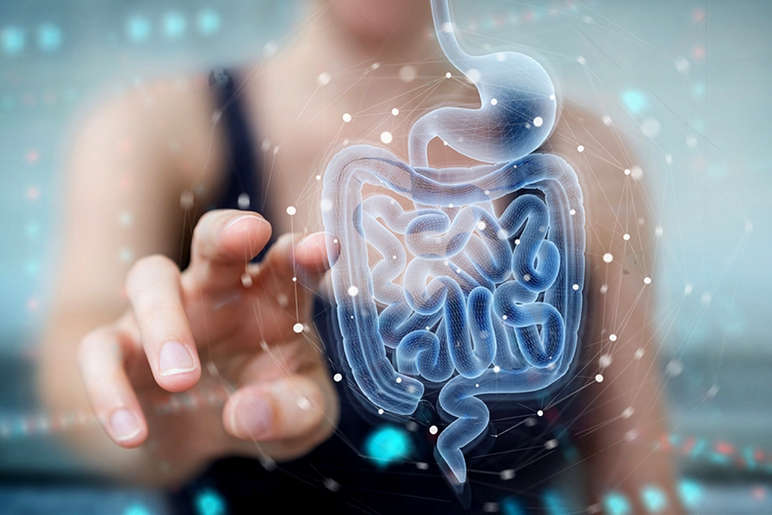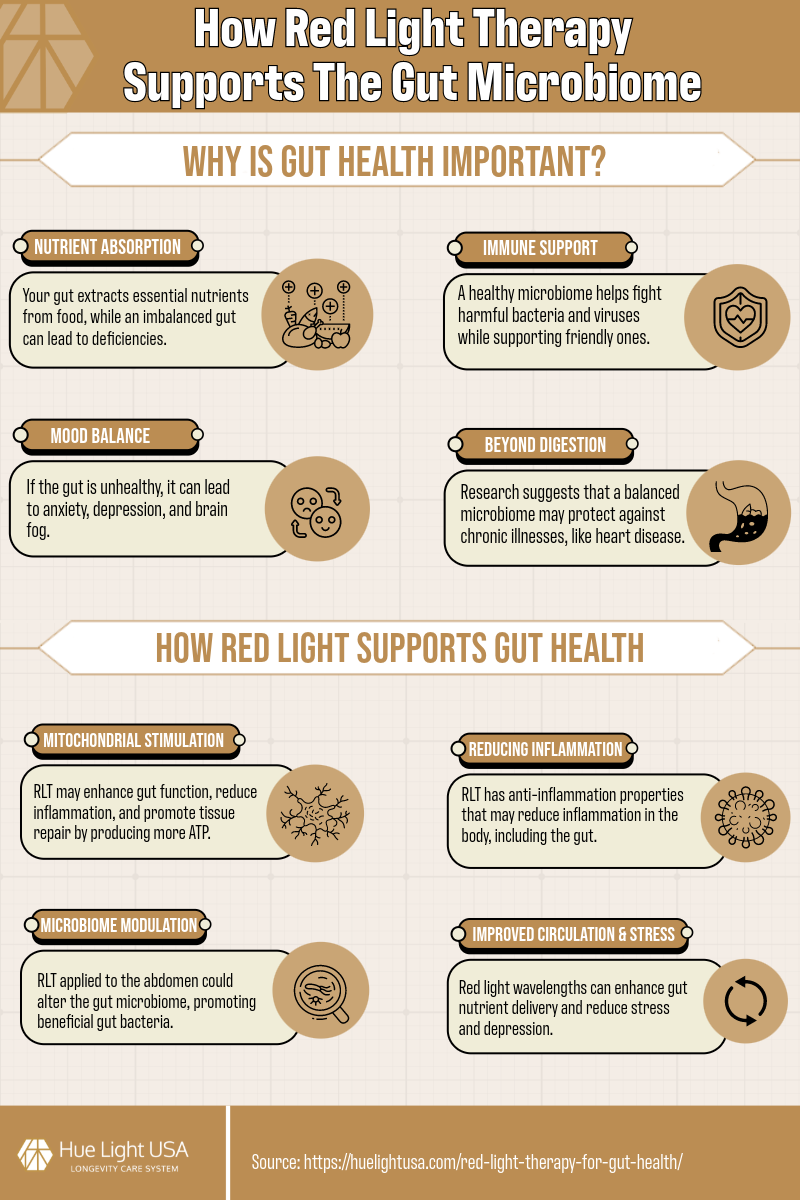
A healthy gut equals a healthier you. Think about this: More than 70% of immune cells can be found in the GI tract.
Therefore, prioritizing gut health enhances your immune system.
So, what can you do to support a healthy gut? Nutrition is one of the best tools for maintaining a healthy gut microbiome. But increasingly, integrative wellness practitioners are seeking novel approaches — like using red light therapy for gut health.
Red light therapy (RLT) works by directing red and infrared light at the body. Red light wavelengths penetrate deeper into the body, and this light triggers a cellular response, stimulating cell mitochondria. This response increases energy production and cellular repair. And, in turn, it’s believed this interaction might positively influence the gut microbiome.
While RLT’s application in skin health and wound healing is widely explored, recent research suggests red light may be a suitable complementary treatment for gut-related disorders.
How, exactly, does red light support gut health? And can it be used for gut disorders like leaky gut or inflammatory bowel disease? This guide takes a closer look and includes links to the latest research exploring red light therapy’s effect on gut health.
The Importance of Gut Health
Think of your gut as the control center of your well-being. It’s not just responsible for breaking down food; it houses trillions of tiny microbes that influence everything from digestion and immunity to mood and brain function.
This incredible community, known as the gut microbiome, keeps everything in harmony. It’s crucial for your overall health.
But why is gut health so important?
- Nutrient Absorption: Your gut extracts essential vitamins, minerals, and energy from your food. An imbalanced gut can hinder this process, leading to nutrient deficiencies and impacting your energy levels.
- Immune Support: Believe it or not, about 70% of your immune system resides in your gut! A healthy microbiome trains your immune system to fight off bad bacteria and viruses while keeping friendly ones thriving.
- Mood Balance: The gut and brain are in constant communication, thanks to the “gut-brain axis.” An unhealthy gut can disrupt this connection and contribute to anxiety, depression, and even brain fog.
- Beyond Digestion: Research suggests that gut health is linked to a surprising range of conditions like heart disease, skin problems, and certain cancers. A balanced microbiome may offer protection against these chronic illnesses.
What Disrupts Microbiome Balance?
Our gut’s delicate ecosystem can be thrown off balance by various factors. This is especially common in modern Western culture, as chronic stress, a highly processed diet, and an overuse of antibiotics can all disrupt the harmony within your gut.
Here are some factors that may contribute to an unhealthy gut microbiome:
- Obesity
- Environmental toxins
- Excessive alcohol use
- Antibiotics wiping out good and bad bacteria
- A diet high in processed foods sugar, and unhealthy fats
Ultimately, a healthy microbiome thrives on balance. And along with a nutritious diet, red light therapy may help to support this balance. Let’s take a closer look.
How RLT Supports Gut Health
RLT and gut health is an exciting new area of reason. And the results have been promising, but still preliminary. While concrete conclusions require more studies, here’s a basic overview of what we know:
- Mitochondrial Stimulation: Photobiomodulation, specifically red light therapy, may directly stimulate cellular energy production. The cells generate more ATP, and, in turn, this may enhance gut barrier function, reduce inflammation, and promote tissue repair.
- Microbiome Modulation: Studies suggest RLT applied to the abdomen can alter the gut microbiome in mice and humans. This may support growth of beneficial gut bacteria. Another study found that Parkinson’s patients saw an increase in two healthy gut bacteria after red light therapy (Bacteroides and Prevotella). Additionally, the researchers found 5 bacteria that have been shown to be increased in the microbiome of Parkinson’s patients had decreased.
- Reducing Inflammation: Indirectly, RLT offers numerous anti-inflammatory properties. This may reduce inflammation throughout the body including the gut.
- Improved Circulation & Stress: The use of red light wavelengths boost circulation. This may help support circulation, resulting in enhanced nutrient delivery to the gut. Preliminary trials have also found RLT to have a stress- and depression-reducing effect, which may affect the microbiome.
Red Light Therapy’s Impact on Gut Microbiome Health

Gut-Related Applications of Red Light Therapy
Our abdominal PBM irradiation device specifically targets the abdomen. As a general support, it’s designed to help soothe the GI tract. However, ongoing research suggests red light therapy shows promise for a wide range of stomach-related disorders.
Here are some examples:
Leaky Gut
Inflammation and gut dysbiosis are common causes of leaky gut syndrome. Gut dysbiosis is characterized by a decrease in microbial diversity and an increase in proinflammatory gut bacteria.
By modulating gut bacteria and reducing inflammation, red light therapy may offer support. Additionally, RLT may help enhance the gut barrier.
Inflammatory Bowel Disease
The anti-inflammatory effects of RLT have been widely explored. And it’s hypothesized this effect may help treat inflammatory bowel diseases. Research, however, is limited to mostly animal models.
For example, one study found that RLT had a positive effect on IBD symptoms of DSS-induced colitis. Researchers found red light was shown to reduce inflammatory infiltrates and ulcers, as well as swelling. Another paper proposed that RLT could help to modulate the symptoms of fatigue, pain and depression that are common with inflammatory bowel disease.
Inflammation from Type-2 Diabetes
Several studies have explored red light’s impact on gut inflammation caused by diabetes. One study, for example, found that during a four-week trial of NIR therapy the non-treatment group had five times more inflammatory areas.
A Possible Link to Brain Health?
The gut-brain axis refers to the complex communication system between the gut and the brain. It’s been proposed that positive changes to the gut microbiome, therefore, may influence brain health.
However, this area is currently under research and there’s yet to be conclusive evidence. It’s been proposed that restoring the gut microbiome may influence several conditions, including:
- Irritable Bowel Syndrome: IBS is believed to be a result of disruption in communication in the gut-brain axis. Therefore, improving the microbiome may help to solve this dysfunction.
- Constipation: The gut-brain axis plays a vital role in gut motility. Therefore, using RLT to stimulate healthy gut bacteria may stimulate gut motility and alleviate constipation symptoms.
Although the link between red light therapy and gut health is promising, it’s important to remember that it’s still experimental. Consult a doctor before trying a self-treatment plan, especially for specific gut conditions.
Wrapping Up
Although RLT for gut health seems promising, it remains a complementary approach to treating GI disorders. It’s also important to manage expectations for red light therapy.
Fortunately, a variety of at-home devices make RLT easier than ever to experiment with. Consult with your doctor before starting a self-directed treatment protocol.
Hue Light USA offers an abdominal red light therapy mat that was designed to treat the GI tract. Using it daily for about 30 minutes may support gut health.







